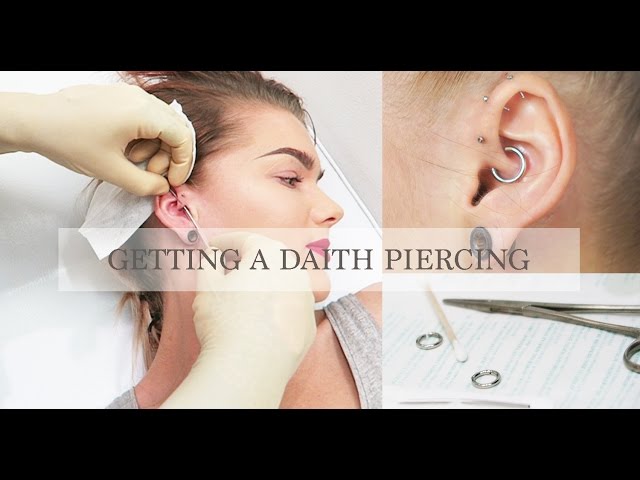Body modifications have long been a means of self-expression, with piercings being one of the most popular forms. Among these, the Daith piercing stands out not only for its unique placement but also for the potential health benefits it claims to offer. This piercing, located in the innermost cartilage fold of the ear, has gained attention both for its aesthetic appeal and its purported ability to alleviate migraine headaches. This article delves into the history, process, care, and potential health benefits of the Daith piercing, providing a comprehensive overview for those considering this stylish and functional form of body art.
History and Origin of the Daith Piercing
The Daith piercing, pronounced “doth,” derives its name from the Hebrew word “da’at,” meaning knowledge. It was introduced in the 1990s by Erik Dakota, a renowned piercer who named it after a client who wanted to express her inner wisdom through a unique form of body art. This piercing quickly gained popularity within the piercing community for its distinct look and the intricacy required to perform it successfully.
The Piercing Process
The Daith piercing is not for the faint-hearted. Due to its location in the thick cartilage of the ear, it requires a skilled piercer with a steady hand and a good understanding of ear anatomy. The process begins with the piercer cleaning the area thoroughly and marking the entry and exit points for the needle. After ensuring that the client is comfortable, the piercer uses a hollow needle to create the piercing, typically followed by the insertion of a curved barbell or captive bead ring.
The pain level experienced during a Daith piercing varies from person to person. Most people describe it as a sharp pinch followed by a dull throbbing sensation. The piercing process itself takes only a few seconds, but the healing process is more extended, ranging from six months to a year. During this time, proper aftercare is crucial to prevent infections and ensure successful healing.
Aftercare and Healing
Caring for a Daith piercing is similar to caring for any other cartilage piercing but with some specific considerations due to its unique location. Here are some essential aftercare tips:
- Cleaning: Gently clean the piercing twice a day with a saline solution. Avoid using alcohol or hydrogen peroxide, as these can dry out and irritate the skin.
- Avoid Touching: Minimize touching the piercing with unwashed hands. This can introduce bacteria and increase the risk of infection.
- Watch for Signs of Infection: Redness, swelling, excessive pain, or discharge are signs of infection. If you notice any of these symptoms, consult a professional piercer or a healthcare provider.
- Be Patient: Cartilage piercings take longer to heal than earlobe piercings. Avoid changing the jewelry too soon and protect the area from physical trauma, such as getting caught in hair or clothing.
Daith Piercing and Migraine Relief
One of the most intriguing aspects of the Daith piercing is its association with migraine relief. This claim is based on the principles of acupuncture, where specific points in the body are targeted to alleviate pain and promote healing. The theory suggests that the Daith piercing stimulates the vagus nerve, which is linked to migraine pain pathways.
Although there is a significant amount of anecdotal evidence supporting the efficacy of the Daith piercing in reducing migraine frequency and severity, scientific research on this topic remains limited. A few small-scale studies have shown promising results, but larger, more comprehensive studies are needed to establish a definitive connection between the Daith piercing and migraine relief.
Aesthetic Appeal
Beyond its potential health benefits, the Daith piercing is a fashionable choice for those looking to enhance their appearance with unique body art. It is versatile and can be adorned with a variety of jewelry styles, including simple rings, elaborate hoops, and delicate barbells. Many people choose to pair their Daith piercing with other ear piercings, creating a personalized and cohesive look.
The placement of the Daith piercing also makes it a discreet option for those who want to express themselves without drawing too much attention. It can be easily concealed by hair or displayed proudly, depending on the wearer’s preference.
Choosing the Right Piercer
Given the complexity of the Daith piercing, it is essential to choose a reputable and experienced piercer. Look for a professional who follows strict hygiene practices and has a portfolio showcasing their previous work. Do not hesitate to ask questions about their experience with Daith piercings and what to expect during the healing process.
Conclusion
The Daith piercing is a captivating choice for those seeking a unique form of self-expression with the added potential benefit of migraine relief. As with any body modification, it is important to do your research, choose a skilled piercer, and follow proper aftercare guidelines to ensure a successful and satisfying experience. Whether you are drawn to the Daith piercing for its aesthetic appeal, its potential health benefits, or both, this distinctive ear piercing offers a blend of style and function that is hard to resist.
